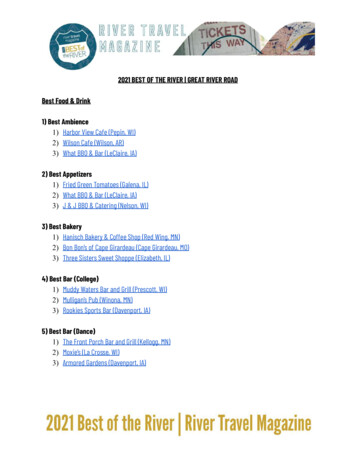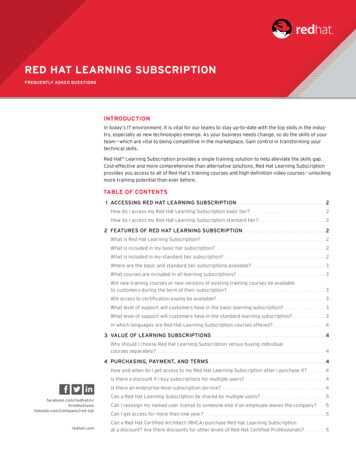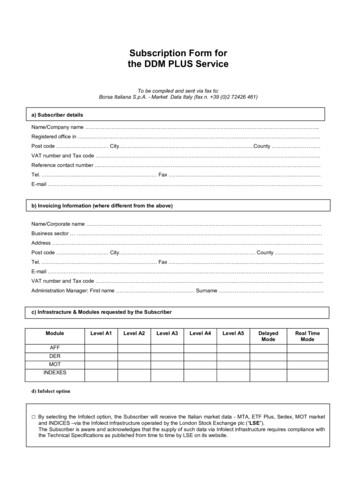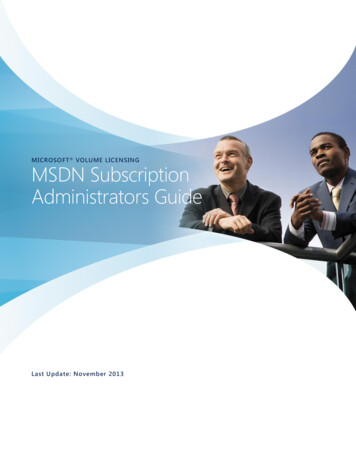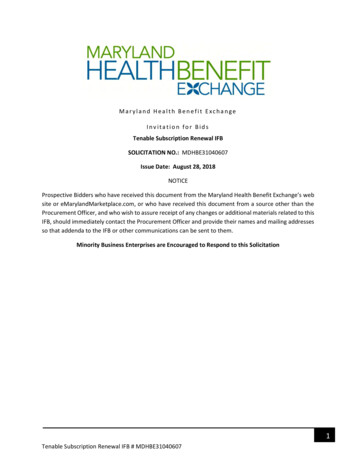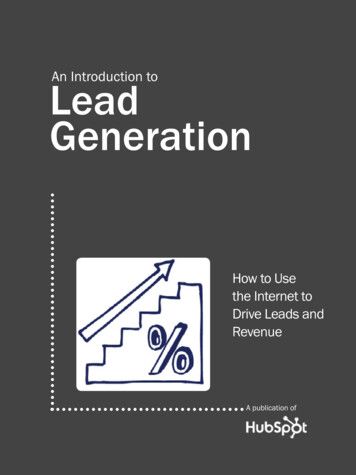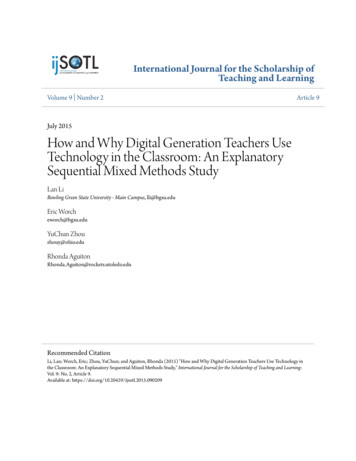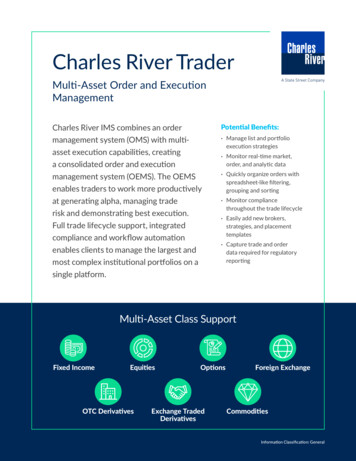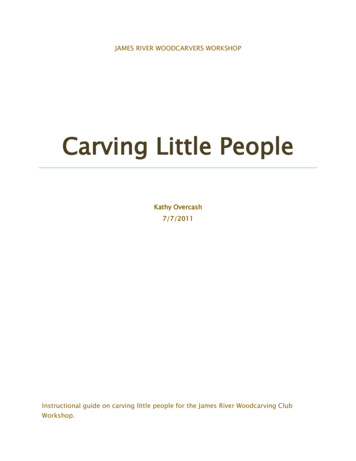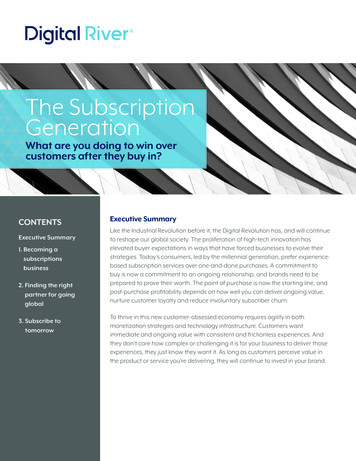
Transcription
The SubscriptionGenerationWhat are you doing to win overcustomers after they buy in?CONTENTSExecutive Summary1. Becoming asubscriptionsbusiness2. Finding the rightpartner for goingglobal3. Subscribe totomorrowExecutive SummaryLike the Industrial Revolution before it, the Digital Revolution has, and will continueto reshape our global society. The proliferation of high-tech innovation haselevated buyer expectations in ways that have forced businesses to evolve theirstrategies. Today’s consumers, led by the millennial generation, prefer experiencebased subscription services over one-and-done purchases. A commitment tobuy is now a commitment to an ongoing relationship, and brands need to beprepared to prove their worth. The point of purchase is now the starting line, andpost-purchase profitability depends on how well you can deliver ongoing value,nurture customer loyalty and reduce involuntary subscriber churn.To thrive in this new customer-obsessed economy requires agility in bothmonetization strategies and technology infrastructure. Customers wantimmediate and ongoing value with consistent and frictionless experiences. Andthey don’t care how complex or challenging it is for your business to deliver thoseexperiences, they just know they want it. As long as customers perceive value inthe product or service you’re delivering, they will continue to invest in your brand.
SECTION 1Becoming a Subscriptions BusinessThe shift from one-and-done purchases to recurringsubscription-like services is leading to the end of the ownershipeconomy as we know it. Regardless of past successes, brandsnow have to keep up with rapidly changing consumer demandsjust to survive. Businesses that can transform a subscriptionmodel into a compelling competitive advantage will thrive.The music industry provides a compelling example of creativemonetization in the face of a seismic shift in buyer preferences.Digital downloads have altered the way we access and consumemusic so significantly that the industry has been forced to worktwice as hard to catch up to the changing demands of the public.Today, users can cherry-pick their favorite songs from albums andstream live music that caters to their personal preferences, withouthaving to own stacks upon stacks of CDs or vinyl records. Pandoraand Spotify have turned the entire industry on its head bycatering to a generation that prefers access over ownership.While critics argue that these changes have hurt the music industry, it’s clear that the consumers have spoken.Easy access and personalization of music will continue to be the main driver in years to come. While the industrypoints out that artists are being hurt by a loss of royalties typically culled from CD and vinyl sales, advocatescounter that new and emerging artists have a much better chance of exposure, and popular bands areincentivized to offer more live shows—an experience-based commodity valued highly by millennials.As online publication Digital Music News points out, there are new and innovative industries cropping up to fill inthe money gap for artists. Sites like Kickstarter, PledgeMusic, Indiegogo and Patreon offer unconventional waysto offer rewards to fan-favorite bands while many other companies look for ways to offer incentives that fans willpay for. And while the big names in music sharing and non-ownership access like Pandora and Spotify might notbe the best revenue models to emulate going forward, they have provided a wonderful litmus test for emergingconsumer trends. Innovative new ideas will inevitably rise through the gaps in traditional markets, begging thequestion: Will your business evolve to meet these new opportunities, or become obsolete in the face of them?Adobe is an excellent example of a successful transition from ownership to access. In 1990, Adobe Photoshop wasreleased to the world as a CD ROM disk that was packaged and available on shelves at big box stores. Startingin 2013, Adobe stopped offering its creative suite as boxed software, instead opting for an entirely subscriptionbased model.1 While the move enraged some users who didn’t appreciate the potential for increased costs, ithas been a highly successful change for the company. In their first year after moving to the cloud, Adobe sharesjumped by 81%. The reason for the spike is due to the company’s profitability since embracing a recurring revenuemodel. Bank of America predicts that the number of subscribers to Adobe’s Creative Cloud will leap to 12.5 millionbetween 2015 and 2019, with the average monthly selling price to rise from 35 to 40 and increased earningsbefore interest and taxes (EBIT margins) to grow from 55% to 60% during that same period.2digitalriver.com2
The temptation for many organizations transitioning to the cloud is to offer multiple price points to make up for lostrevenue, but Adobe’s success while offering three to four simple pricing options has proven that consumers prefersimple pricing plans. While there are pros and cons to both perpetual licensing and product-as-a-service, the cloudbased SaaS model that Adobe has adopted benefits everyone. Consumers benefit from a reduction in versioncompatibility errors and being able to spread out smaller payment amounts over time. IDC analyst Al Hilwa says“Most small shops are likely to find the subscription more palatable than large outlays of funds.”3 While the averageorder value declines under the SaaS model, the revenue cycle is more predictable and the company becomes moreprofitable due to reduced customer acquisition costs.Most common types of subscriptionsIf you’re considering a move to a subscription model, you’re in good company. Subscriptions and recurring billingmodels are on the rise and highly successful when done right. But before you adopt a subscription model, you first needto understand which model will appeal to your customer base, work best for your products or services, and align withorganization’s business goals. Here are three common types of subscription services:ReplenishmentNeed-based consumergoods best sold throughpassive purchasing.DiscoveryExperience-driven goodsthat give consumers theimpression that they’rereceiving a gift.Productivity enablingAccess-based convenienceservices that makeconsumers more productivein their daily lives.Replenishment-based subscriptionsReplenishment-based subscriptions are most often used for those everyday products that people have cometo rely on as part of their daily routine. In an increasingly flexible and connected world, the workday rarely comesto a resolute end, and exhausted consumers view activities like shopping for toothpaste or socks as chores.Co-founder of the London Sock Company, Ryan Palmer said bluntly in a recent interview with the Telegraph,“Who wants to go shopping for socks?” His sock subscription program takes a typically dreary purchase andmakes it into a fun monthly package that arrives at customers’ doors. He says “They [socks] are an add-on These services make style more accessible with very little effort required.”5 The genius of this particular modelis that it has taken a replenishment-based need and packaged and distributed it in a way that is interestingand fun.One much talked about and highly successful company that has latched on to the replenishment-based model isDollar Shave Club, a California startup that delivers razors to customer doorsteps at budget prices—a grassroots,simple subscription club that is causing major upset to mainstream, established players. Putting a dollar amountto Dollar Shave Club’s success, Unilever purchased the company in July, 2016 for 1 billion dollars in cash.6 It’s notjust small startups who are getting in on the action. Retail giants like Amazon and Target were first in line withservices like Amazon Pantry and Target Subscriptions, both of which offer incentives and discounts to consumerswilling to sign up for monthly subscriptions. By offering these discounts and incentives, brands areable to secure loyalty initially without the need to compete every time a consumer makes a purchase. It is trulya set-it-and-forget-it model, and an advantage for businesses familiar with ruthless competition.digitalriver.com3
Discovery-driven subscriptionsPerhaps best epitomized by the recent craze in subscription boxes, experience-based or ‘discovery’ subscriptionsoften come with a surprise gift and are marketed to consumers who buy certain types of goods regularly —from beauty products to pet food—but don’t have a specific brand loyalty. Subscribing to a box is like havinga personal shopper curate a selection of goods for you, allowing consumers to access what is essentially anexperience-driven model. Graze, a subscription snack box allows customers to personalize their preferences butstill allows flexibility for surprise and delight as the company curates new, novel munchies into every box. Anotherhugely popular subscription box is StitchFix, a personal styling fashion box that tailors hand-picked outfitsaccording to taste, budget and lifestyle. Both examples take a potentially difficult and frustrating experienceand replace it with a personalized, seamless subscription. The popularity of these boxes is eagerly shared byconsumers, with plenty of social media shares and even videos of “unboxing” — a practice that demonstrates thedelight recipients experience when opening their boxes.Hitwise recently suggested that part of the growing popularity of the subscription boxes can be traced toconsumer fatigue as “consumers are faced with a seemingly impossible diversity of choice; none more so thanthe generation that came of age with the Internet and online shopping.”7 Subscriptions offer an excellent antidoteto this fatigue by leading consumers to curated products. More and more businesses are getting on board, andwhile the subscription box sites are still a niche market, it isn’t one that looks to be slowing down anytime soon.Productivity-enabling subscriptionsThese subscriptions offer access to increased productivity based on already familiar tasks—whether it be inyour personal life, or at work. A familiar example is Apple’s subscription to increased digital storage on iCloud.Consumers who would traditionally need a physical hard drive to back up and store files can now simplysubscribe for more space. This simple, barrier free subscription service not only makes users lives measurablymore productive; it guarantees an easy recurring revenue stream for Apple. A lot of productivity-enablingproducts work on tiered subscription platforms, with more expensive tiers offering additional benefits.These tiers are scalable and make incentivizing upgrades to existing subscribers easy. Slack, a team organizationtool, is a great example of how productivity-enabling subscription products can be enriching and valuable forbusiness and individuals who find that the small dollar amounts are worth the returns in increased productivityand time management.Regardless of which category your product or service works best with, subscriptions are fulfilling consumer desiresfor fun, seamless service in lieu of tedious shopping trips and misspent time. Consumers aren’t going to stopsnacking, feeding their pets or getting dressed, but the way in which they consume products is changing quicklyand businesses need to accommodate these new habits or be left behind.digitalriver.com4
Recurring billing modelsAt a bird’s-eye level, there are three basic recurring billing models to consider:Prepaid subscriptionsTerm-based subscriptionsUsage-based billingWith a prepaid subscriptionmodel, there is no longterm commitment. Instead,consumers prepay on amonthly or annual basis, andservices end when paymentsstop. Think Netflix. Fromantivirus subscriptions toDollar Shave Club, prepaidsubscription models are familiarto most consumers, whichcan be an advantage forbrands who want to minimizebarriers to adoption. Anotheradvantage of this model is itssimplicity, as it’s the easiestto implement.Another subscription paymentmodel to consider is the termbased contract subscription. Ifyou’ve ever had a contract witha cable or satellite provider,you’ve partaken in this modelas a consumer. In essence,the customer commits to aset term of service (12 months,2 years, etc.) but is billed ona different cycle such as ona monthly or quarterly basis.One key advantage is thefinancial predictability thismodel brings, but in exchangefor commitment, brands mustoften entice consumers witha discount.The third common subscriptionbased payment model is usagebased, in which consumersonly pay for what they useafter they’ve used it. Whileappealing to the customer,this model can provide a levelof unpredictability for bothparties. The “surprise” factorcan lead to charge disputesand unpaid bills. As a result,many businesses only leverageusage-based billing for thingslike overages or special serviceson top of a regular subscription.For example, a consumer paysa fee in addition to theirmonthly cable bill foron-demand movies.digitalriver.com5
Important considerations for shifting to a subscriptions modelUnderstanding how your service or product will best translate into a recurring revenue model is the first step inmaking that crucial transition. Millennials, the market’s most fluent digital natives are leading the way and supportingcompanies with innovative ideas on how products can be bought and consumed. Businesses should take note as datashows that where millennials go, the rest of the consumer market is likely to follow. Subscriptions and other types ofrecurring transactions are expected to overtake one-off purchasing.Autodesk is an example of a business that has made a successful shift to keep their business growing strong intothe future. With their new subscription model, Autodesk has successfully linked their traditional products—desktopapplications—with cloud-based support elements and updates leveraged within a subscription pricing model. Workingfrom the cloud al
a personal shopper curate a selection of goods for you, allowing consumers to access what is essentially an experience-driven model. Graze, a subscription snack box allows customers to personalize their preferences but still allows flexibility for surprise and delight as the company curates new, novel munchies into every box. Another hugely popular subscription box is StitchFix, a personal .
